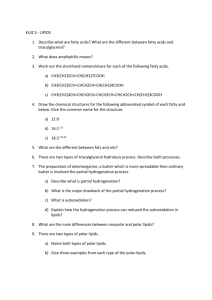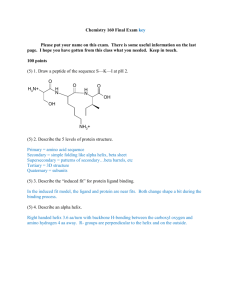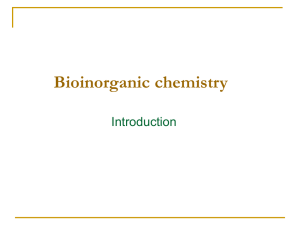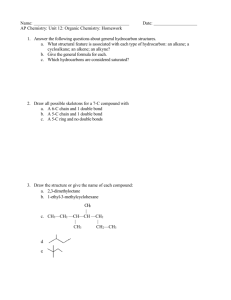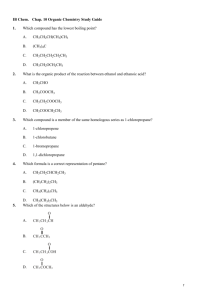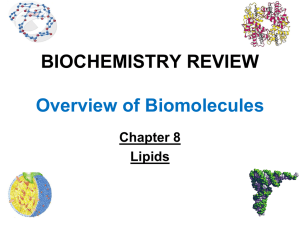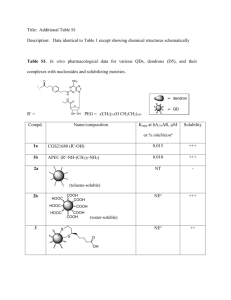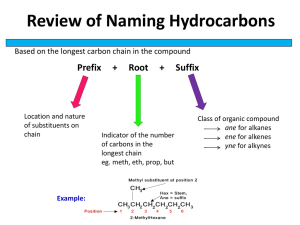Lecture Slides for Lipids
advertisement
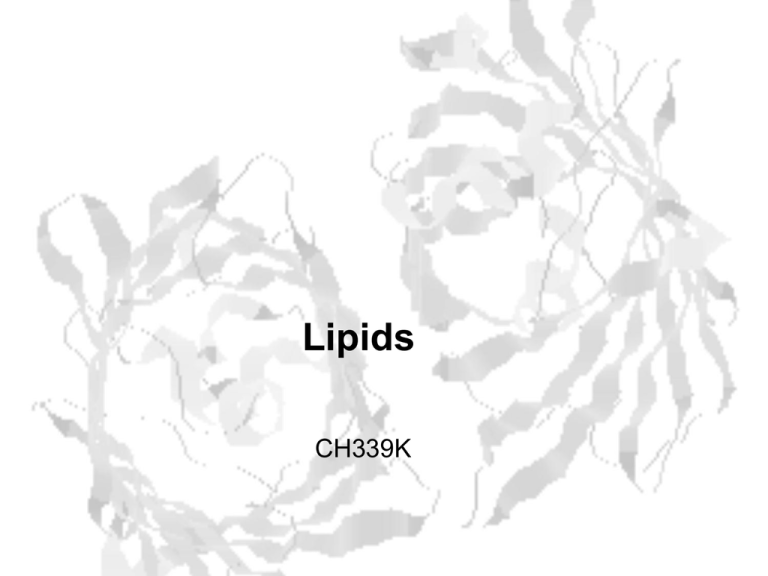
Lipids CH339K What are lipids? • Grab bag of molecular types • Common link is their hydrophobicity – Fats – Glycerophospholipids – Sphingolipids – Waxes – Eicosanods – Steroids – And other stuff F A T T Y A C I D S You can’t make fatty acids where the double bond is 6 carbons or closer to the end of the molecule In living systems, the double bonds of unsaturated fatty acids are usually cis-. Melting Temps of Fatty Acids Saturated Formula CH3(CH2)10CO2H CH3(CH2)12CO2H CH3(CH2)14CO2H CH3(CH2)16CO2H CH3(CH2)18CO2H Common Name lauric acid myristic acid palmitic acid stearic acid arachidic acid Unsaturated Melting Point Formula 45 ºC CH3(CH2)5CH=CH(CH2)7CO2H 55 ºC CH3(CH2)7CH=CH(CH2)7CO2H 63 ºC CH3(CH2)4CH=CHCH2CH=CH(CH2)7CO2H 69 ºC CH3CH2CH=CHCH2CH=CHCH2CH=CH(CH2)7CO2H 76 ºC CH3(CH2)4(CH=CHCH2)4(CH2)2CO2H Common Name palmitoleic acid oleic acid linoleic acid linolenic acid arachidonic acid Melting Point 0 ºC 13 ºC -5 ºC -11 ºC -49 ºC (Glycerol tripalmitate) Grandma’s Lye Soap (Saponification) Fatty Acid Salts are Amphipathic Waxes Very often – fatty acid + long-chain alcohol. Plant leaf cuticle Insect epicuticle Beeswax components Spermaceti •Largely cetyl palmitate •Large whale may have 3 tons •May function as lens in echolocation •May function as shock absorber in combat •Sank the whale ship Essex in 1820 What happens if I substitute something else for a fatty acid in a fat? Like a Phosphate? This also is Amphipathic Phospholipids in H2O Cardiolipin(s) Glycerol Major component of inner mitochondrial membrane (up to 20%) R groups usually c18:2 Major component in heart muscle membranes Causes platelet aggregation and vasodilation (inflammatory mediator). Important to the process of hemostasis. Important in implantation. Concentration of 10-12 M causes life threatening inflammation of the airways (asthma-like symptoms). Toxins such as fragments of destroyed bacteria induce synthesis of PAF causes drop in blood pressure reduced volume of blood pumped by the heart shock and possible death. Glycolipids Archaea have weird membrane lipids Archaean membrane lipids Polymers of isoprene Sulfolobus solfataricus Sphingolipids Sphingosine by itself Defective ganglioside digestive enzymes cause disease Tay-Sachs – a Defect inSphingolipid Metabolism As a child with Tay-Sachs grows older, he or she may become blind, mentally retarded, paralyzed, and unresponsive to the environment. The child also may have seizures, difficulty swallowing, and difficulty breathing. Children with Tay-Sachs disease rarely live beyond 4 or 5 years of age. Tay-Sachs – a Defect inSphingolipid Metabolism Mutation in lysosomal enzyme Hexosaminidase A Cholesterol Steroid Hormones Steroid Testosterone Estradiol Cortisol Aldosterone Prednisolone Prednisone Function Boys Girls Turns on gluconeogenesis Inhibits immune response Turns on Metabolism Increases sodium retention Increases potassium secretion Increased blood pressure Inflammatory and autoimmune diseases Immunosuppressant Source Testis (ovary) Ovary (testis) Adrenal Cortex Adrenal Cortex Drug Drug Bile Salts Bile salts are steroid acids Bile Salts solubilize fats in the digestive tract Derivatives of Arachidonic Acid • Leukotrienes – conjugated double bonds •vasoconstrictors • Thromboxanes – 6-membered ring •Clot formation • Prostaglandins – 5-membered ring •Many functions •Inflammatory response •Vasodilators •Pyogenic Prostacyclin Eicosanoid functions • Prostaglandins have 5- or 6-membered ring – Short-range hormones mediating (among other things) pain and inflammation, uterine contraction • Prostacyclins have a double ring structure – Inhibit clotting, vasodilators • Thromboxanes are made in platelets, contain oxygen in the ring – Vasoconstrictors, hypertensives, aggregate platelets • Leukotrienes have 3 conjugated double bonds – Asthmatic, allergic, and inflammatory responses NSAIDs like aspirin, ibuprofen, and naproxen inhibit eicosanoid formation Phospholipids in H2O Lipid Bilayer Cell Membrane Integral and Peripheral Proteins Membrane Functions Membrane Composition Membrane Composition Erythrocyte Membrane – differences between inner and outer layers 2-Dimensional Fluids Membranes exist in 2 states Phase transition Factors Impacting Tm • Chain length – Longer chains more vdW contacts (higher Tm) • Unsaturation – Unsaturated FAs fewer vdW contacts (lower Tm) • Size / Charge of head groups – Big head groups steric interference lower Tm) – Charged head groups electrostatic repulsion lower Tm) • Cholesterol – Interferes with packing at low temps – Stiffens membrane at high temps – Broadens melting curve Some organisms change their membrane composition seasonally in order to maintain constant fluidity Egregia menziesii Winter Spring Summer Fall SFA 29.6 35.6 34.1 31.4 MUFA 13.3 17.8 16.7 16.3 PUFA 57.1 46.9 49.3 52.3

